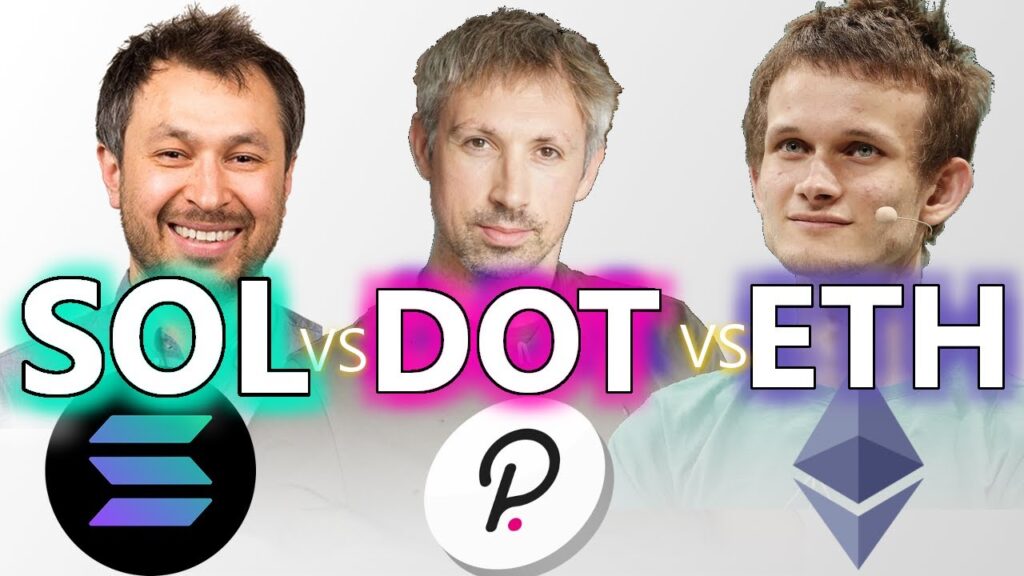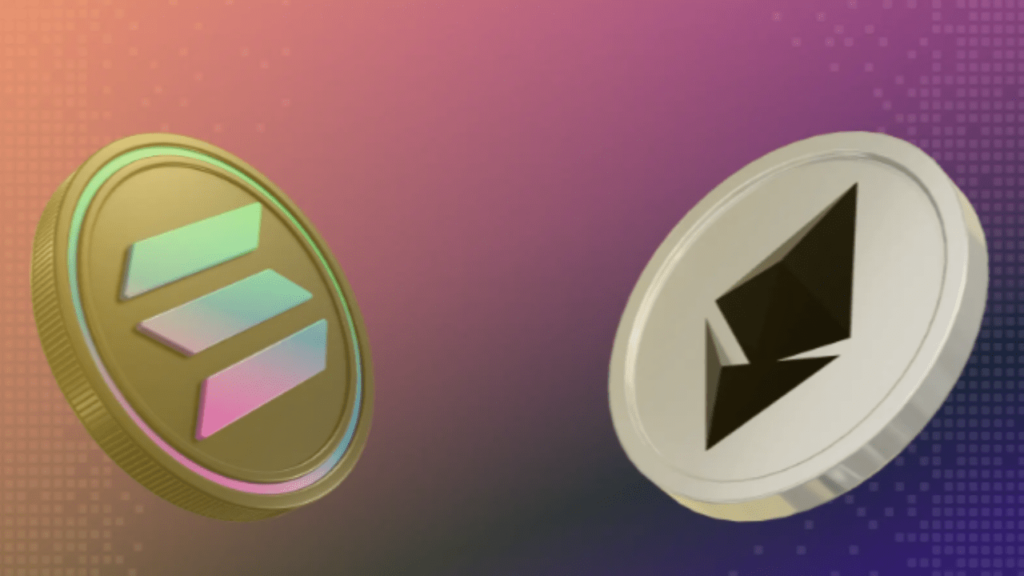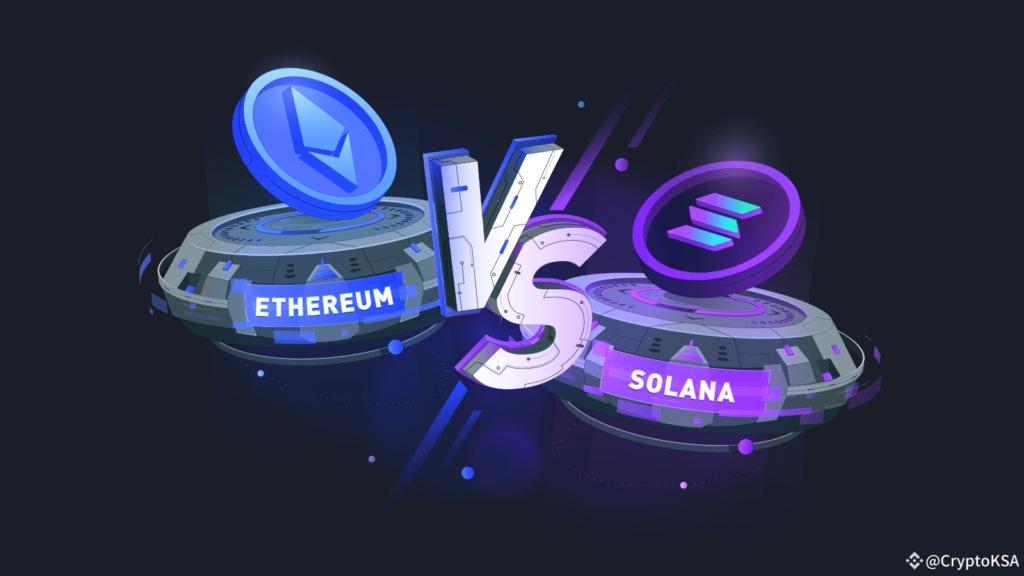
Introduction
If you’ve dipped your toes into crypto, you’ve probably heard these two names more times than you’d care to count: Ethereum and Solana. They’re like the Coke and Pepsi of smart contract platforms.
But here’s the million-dollar question (literally): Which one deserves your investment in 2025?
Whether you’re a cautious newbie or a seasoned degen, this article breaks it all down in plain English—no confusing jargon, no unnecessary hype. Let’s dive in.
Quick Overview: Ethereum vs Solana
Ethereum: The OG Smart Contract Platform
Ethereum basically wrote the book on smart contracts. Launched in 2015 by Vitalik Buterin and crew, it was the first blockchain to enable developers to build decentralized apps (dApps).
Think of Ethereum as the Apple of crypto—established, trusted, but sometimes… a little expensive.
Solana: The Speed Demon of Layer 1s
Solana hit the scene in 2020 like a rocket ship. It’s all about speed and low fees, aiming to solve Ethereum’s congestion and cost problems.
Think Solana = Tesla on turbo mode. Slick, fast, but still working out the kinks.
Key Differences Between Ethereum and Solana
Consensus Mechanism
- Ethereum uses Proof of Stake (PoS) since The Merge in 2022.
- Solana uses a combo of Proof of History (PoH) + Proof of Stake, which allows for ultra-fast validation.
⏱️ Verdict: Solana wins on speed, but Ethereum takes the lead on decentralization and reliability.
Scalability and Speed
- Ethereum: Around 30 TPS (transactions per second) in its current form.
- Solana: Boasts up to 65,000 TPS (though it’s often debated).
🚀 Solana’s got the edge here—but sometimes it’s too fast for its own good, leading to outages.
Developer Ecosystem
- Ethereum has the largest army of developers in Web3.
- Solana is catching up, but still has a smaller dev community.
👨💻 Bigger developer base = more dApps, more innovation.
Security and Decentralization
- Ethereum: Highly decentralized, with thousands of validators.
- Solana: Fewer validators, which raises concerns about centralization.
🔐 If you’re all about security and decentralization, Ethereum is your go-to.
Gas Fees and Transaction Costs
- Ethereum: Can get pricey, especially during peak times.
- Solana: Fraction-of-a-penny fees—basically free.
💸 Solana is miles ahead on affordability.
Real-World Use Cases

Ethereum’s Role in DeFi, NFTs, and DAOs
- Home to DeFi giants like Uniswap, Aave, and Maker.
- Dominates the NFT space (OpenSea, anyone?).
- DAO creation is thriving on Ethereum.
🧠 Think of Ethereum as Web3’s infrastructure backbone.
Solana’s Role in Web3, Gaming, and Microtransactions
- Powering high-frequency apps and NFT marketplaces like Magic Eden.
- Great for gaming platforms like Star Atlas and Aurory.
- Built for microtransactions, thanks to low fees.
🎮 Solana’s niche? Fast, interactive, and user-driven applications.
Price History and Market Performance
Ethereum Price Trends and Growth Potential
- 2015 launch price: under $1
- 2021 all-time high: ~$4,878
- 2025 (as of now): steady between $3,000–$4,000
📈 Strong history, wide adoption, and tons of upside potential.
Solana Price Trends and Risk Profile
- 2020 launch: ~$0.22
- 2021 ATH: ~$260
- 2022-2023: hit hard, dropped under $20
- 2025: rebounding in the $150–$200 range
⚠️ Higher volatility, but also higher upside for risk-takers.
Network Adoption and Ecosystem Growth
Number of Developers
- Ethereum: 4,000+ active developers
- Solana: ~1,000 active devs
👷♂️ Ethereum leads by a mile, but Solana is growing rapidly.
Number of DApps
- Ethereum: Thousands
- Solana: Several hundred, but growing
📲 Ethereum has the edge in mature, audited applications.
Institutional Support
- Ethereum: Backed by ConsenSys, major banks, and ETFs.
- Solana: Backed by VC firms like a16z and FTX (before the collapse).
🏦 Ethereum is seen as the “institutional favorite.”
Future Roadmaps

What’s Ahead for Ethereum (Ethereum 2.0)
- Sharding is coming to improve scalability.
- More Layer 2 integration (Arbitrum, Optimism).
- Focused on sustainability and security.
🚧 Ethereum is building long-term, slowly but surely.
What’s Ahead for Solana (Firedancer and Beyond)
- Firedancer validator client (built by Jump Crypto) will boost performance and reduce outages.
- More focus on mobile and user experience.
🔥 Solana is sprinting ahead, but with a few hurdles on the track.
Pros and Cons of Investing in Ethereum
Pros:
- Massive developer and user base
- High security and decentralization
- Long-term viability
- Tons of integrations
Cons:
- High fees
- Slower innovation pace
- May feel “established” (less upside)
Pros and Cons of Investing in Solana
Pros:
- Extremely fast and cheap
- Growing dev community
- Lots of future potential
- Great for interactive dApps
Cons:
- Less secure and decentralized
- History of outages
- Higher risk, higher volatility
Ethereum vs Solana: Side-by-Side Comparison Table
| Feature | Ethereum | Solana |
|---|---|---|
| Launch Year | 2015 | 2020 |
| TPS (approx) | 30 | 65,000 |
| Average Fee | $5–$50 | <$0.01 |
| Consensus | Proof of Stake | PoH + PoS |
| Security | Very High | Moderate |
| Decentralization | Highly Decentralized | Less Decentralized |
| Ecosystem Size | Largest in Web3 | Growing rapidly |
| Best Use Case | DeFi, NFTs, DAOs | Gaming, NFTs, Microtransactions |
| Volatility | Moderate | High |
| Risk Level | Lower | Higher |
Investment Strategies Based on Your Risk Appetite
Conservative Approach
Go heavy on Ethereum. It’s the safer bet with long-term upside.
Balanced Strategy
Split between Ethereum (70%) and Solana (30%). Enjoy stability while exposing yourself to potential growth.
High-Risk, High-Reward Strategy
Lean into Solana. You could see massive gains—or feel the burn. Use only what you can afford to lose.
Which One Should You Choose? Our Take
- Want stability, security, and long-term growth? Ethereum’s your guy.
- Want speed, innovation, and higher upside? Solana might be the one.
But here’s the secret sauce: Why not both? Diversification is the ultimate crypto cheat code.
Conclusion
At the end of the day, Ethereum and Solana aren’t enemies—they’re two sides of the Web3 coin. Ethereum is the tried-and-true veteran; Solana is the fearless upstart.
Instead of betting everything on one horse, consider how each fits into your personal investment strategy. Because in crypto, knowledge is power—and you just leveled up big time.
FAQs
1. Is Ethereum safer than Solana?
Yes—Ethereum has better decentralization and a longer security track record.
2. Can I stake both Ethereum and Solana?
Absolutely. Both blockchains support staking and offer decent yields.
3. Which one is better for NFTs?
Ethereum dominates high-end NFTs. Solana is catching up with fast, cheap transactions for smaller collections.
4. Will Solana ever “flip” Ethereum?
It’s unlikely in the short term, but never say never in crypto. Solana’s innovation speed is impressive.
5. What if I invest in both?
Smart move! Diversifying helps you manage risk while maximizing opportunity.